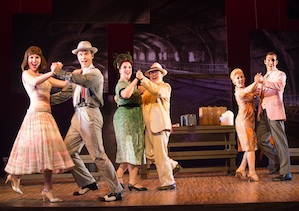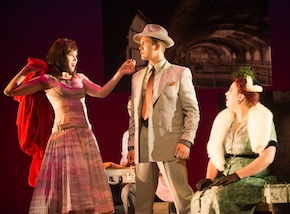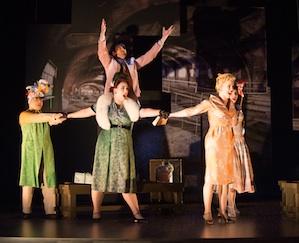
Domenick Argento and John Donahue’s Postcard from Morocco is as compelling as it is enigmatic. Donahue’s libretto, which sets the fantasy in a railway station in Morocco circa 1914 “or some place, hot and strange,” concerns seven individuals, each of whom is doing their best to protect the part of themselves that they’ve secreted in their small suitcase. Whether the suitcase’s contents are of relative or ultimate consequence, real or fantasy, is never revealed; all we know for sure is that secrecy is so important to this curious collection of individuals that they are identified solely by their containers (e.g. A lady with a Hand Mirror, A Man with Old Luggage, and so on).
In the course of 90 or so minutes — amidst a puppet show, luncheon band entertainment, and vignette from a fantasy operetta — only one character, A Man with a Paint Box (aka Mr. Owen), eventually opens himself emotionally. How the other characters react to his vulnerability, guard their secrets, and, in Mr. Owen’s case, pick up the pieces of what might have been or is yet to be provides the crux of the action.
Argento’s post-romantic dreamscape of a score is a joy. Distinctly modern but never forbidding chromaticism contrasts with romantic quotations from Wagner’s The Flying Dutchman, vague references to Bizet’s The Pearl Fishers and Donizetti’s Lucia di Lammermoor, and, amidst the covert craziness, a gorgeous Viennese duet that screams Lehar with a bit of Strauss’ Der Rosenkavalier boudoir craziness thrown in for good measure. There are also wonderful timbral contrasts in the orchestra — passages where the music passed from Donald Kennelly’s trombone to Paul Psarros’ guitar to Mike Corner’s saxophone were especially delicious.
Triumphs

Ideally constructed for the small stage of the Cowell Theatre at Fort Mason, the one-act chamber opera calls for only seven singers, several of whom play multiple parts, and eight instrumentalists (when some double up as in San Francisco). But it requires something more than good voices and instrumentalists and a conductor with the assurance of Mark Morash. Postcard from Morocco demands a canny director who can help the singers wrap themselves around the ultimately unfathomable, and transform each physical and musical gesture into something that demands attention.
Here, Director Peter Kazaras’ production went only half way. His major success, and the triumph of the opera, was tenor AJ Glueckert’s masterful performance (A Man with a Paint Box/Mr. Owen). At first a woeful presence, Glueckert’s beautifully paced portrayal grew in stature as the opera progressed. Initially expressing one of the confused throng, his lost expression became filled with life as his voice and suitcase opened. Glueckert’s timbre is distinctive, and distinctively beautiful. His tone may not have been consistently pure, nor the lowest notes always clear, but the power and uniqueness of voice and artistry carried the show.
Coloratura soprano Suzanne Rigden (A Lady with a Hand Mirror/An Operetta Singer) was almost as commanding. Her voice is large and very bright, her vocalism secure, and her movements lovely to watch. Only the lack of a distinctive timbre and clear characterization held her back from breaking through the opera’s intentional fog.
Challenges

The performance was especially puzzling because Kazaras failed to sharply delineate the characters, their interactions, and their relationship to their defining possessions. (Thanks to Kristin in Karen Ames’ office and the Merola staff, I’ve had copies of the premiere recording and the libretto to help piece things together.) In the puppet show, for example, bass Matthew Scollin (A Man with a Cornet Case/A Puppet Maker) made fascinating expressions and sang well, but neither his gestures nor his neither here nor there puppet maker accent ever made clear that he was presenting a puppet show, let alone controlling the actions of multiple characters.
Not that Scollin was helped by the direction of his puppets, baritone Joseph Lattanzi (A Man with a Shoe Sample Kit/Second Puppet) and tenor Andrew Stenson (A Man with Old Luggage/First Puppet/An Operetta Singer). Thanks to what appears to be training in dance theater, Melecio Estrella’s joyful choreography, and Kristi Johnson’s delightful costumes, the ever-engaging Lattanzi was a special joy as he danced, spun around, and mugged like a younger version of Joel Grey meets Tommy Tune. But while his baritone gained in focus and strength as the evening progressed, his dancing was such a standout that it became an end in itself, without any grounding in the admittedly at sea scenario that was unfolding around him.
That may sound like a backhanded compliment, but it points to Kazaras’ failure to fully integrate Lattanzi’s gifts into the ensemble. Were Lattanzi and Stenson puppets, or simply passengers prone to break into song and dance routines? Even though we can never know what is going on with this curious assortment of individuals, it doesn’t help that we can’t figure out that we’re never supposed to know. Nor were Stenson’s expressions and movements a match for Lattanzi’s, or his light lyric tenor able to hold its own in his operetta duets with Rigden.
Mezzo-soprano Carolyn Sproule (A Lady with a Hat Box/A Foreign Singer) was another enigma. The voice was strong, but the only time any sense of personality emerged was when she was singing in ensemble. Soprano Aviva Fortunata (A Lady with a Cake Box) showed us voice equally strong and face equally enigmatic, but her emotional commitment managed to break through the haze. As with Glueckert, she touched the heart. Only when the two of them interacted did we have a sense that something profound was unfolding amidst Nicholas Muni’s simple sets and Argento’s masterful score.

